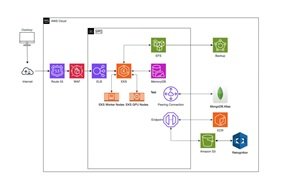Education
IDC Releases Report on AI-Powered Adaptive Education Industry, Revealing Opportunities and Future Trends of AI in Education

SHANGHAI, July 2, 2025 /PRNewswire/ — In March 2025, IDC (International Data Corporation) released the report “AI-Powered Adaptive Education: Opportunities and Trends,” which provides a comprehensive analysis of the current trends, application scenarios, case studies, and industry insights in the AI education sector. The report showcases the immense potential of AI to disrupt traditional education models and empower the education industry, offering detailed references for educators, investors, and all parties interested in the development of the education sector.
Current Situation Analysis: AI in Education-Immediate Assistance and Long-Term Promotion
With the rapid development of technology, artificial intelligence is gradually permeating and profoundly changing various industries, and the education sector is no exception. The report suggests that the AI intelligence level in the education industry is steadily advancing along a six-level evolution path from Level 0 to Level 5, marking a profound transformation of the education model from a basic digital stage to a full-scenario intelligent education agent.
At the Level 0 basic digital stage, the emergence of electronic textbooks with static content storage and zero adaptive capabilities, online education resource libraries, and educational apps (for querying and browsing content) has enabled the migration of educational resources from paper to electronic media.
Entering the Level 1 response-based intelligent stage, the system is upgraded to an AI system with basic response capabilities, capable of performing keyword-based responses and standardized resource pushing. Online learning machines and question-and-answer analysis tools have become typical applications of this stage.
At the Level 2 context-aware stage and Level 3 simulated interaction stage, the level of AI intelligence has gradually been upgraded to systems with elementary cognitive abilities that can analyze learning behaviors and dynamically adjust difficulty (Level 2), and AI educational agents with human-like conversational abilities (Level 3) that can perform natural language processing, generate teaching strategies, deeply understand learning situations, and conduct multi-turn instructional conversations.
With the advent of the Level 4 educational large-model stage, the level of AI intelligence has gradually evolved to feature multi-modal teaching understanding and adaptive education. Based on a strong cognitive system of vertical large models in education, products such as comprehensive adaptive learning platforms and integrated virtual-real teaching spaces have successively entered the market.
Finally, at the Level 5 stage, represented by AI intelligent teachers, the full-scenario educational intelligent agent is the ultimate form of expression for ed-tech companies after entering the intelligent development stage of education. Level 5 full-scenario educational intelligent agents integrate the capabilities of Level 4 large models, incorporating functions such as personalized learning, emotional support, situational awareness, adaptive teaching, and MCM (Mode of Thinking, Capacity Building, and Methodology) training, enabling cross-disciplinary knowledge integration and dynamic teaching strategy generation.
In the intelligent development process of the education industry, Level 5 is equivalent to the highest level in the autonomous driving field, representing an advanced state of full autonomy and no need for human intervention. Squirrel Ai’s intelligent teacher is a typical representative case. Sullivan’s “2024 China Intelligent Learning Machine Industry White Paper” has evaluated Level 5 representatives, pointing out that Squirrel Ai’s intelligent teacher is the only application to reach Level 5. Ernst & Young’s “China Adaptive Education Industry White Paper” also lists Squirrel Ai’s intelligent teacher as a representative application that has reached a fully adaptive education level. With core drivers such as recognition and interaction, data processing and learning, and cognition and intelligent reasoning, Squirrel Ai’s intelligent teacher has successfully realized an ideal adaptive education model where all aspects from teaching preparation to teaching implementation and feedback are independently handled by AI, truly achieving a state where no human teachers are needed for additional intervention, covering various scenarios such as classroom teaching, home tutoring, and social practice.
Under this growth rate, the core impact of AI-powered education is also becoming increasingly apparent. It is mainly manifested in two major aspects:
On the immediate assistance level, AI can achieve performance improvement in the short term. A variety of AI products have built an intelligent tool matrix that can quickly respond to students’ personalized learning needs. With the help of intelligent devices, the real-time monitoring and feedback mechanism for students’ learning behaviors and environmental changes can effectively enhance the learning experience. At the same time, AI technology supports seamless switching and integration of various learning models online and offline, and across different terminal devices, ensuring that students can obtain the required learning resources in the most convenient way, meeting the development of personalized needs.
On the long-term promotion level, AI can achieve long-term capability improvement by changing learning habits. This mainly includes five major aspects: the transformation of learning methods, the fairness of educational resources, the popularization of adaptive education, immersive learning, and intelligent supervision.
The report points out that AI technology, as a bridge, can transport high-quality educational resources to remote and resource-poor areas, narrowing the educational gap. At the same time, adaptive education, as an important technology and application for personalized education, has its widespread popularization, which can provide students with personalized learning path planning. Combined with gamification and competitive interaction elements, it creates an immersive learning environment, stimulates learning interest, and guides students to transition from surface learning to deep understanding of knowledge and cultivation of critical thinking and innovation abilities. In addition, in Google’s “Future of Education” report, adaptive education is regarded as one of the three major technological trends and the core technology for global ed-tech companies to transform and invest in research and development since the beginning of the AI era.
With the dual support of advanced large-model technology and deep learning algorithms, AI has gradually taken on the role of an “intelligent guardian,” providing students with all-round guidance and support.
Application Scenarios: Multi-modal Interaction and Adaptive Large Models Lead the Trend
As AI technology continues to permeate the education sector, its application scenarios are also becoming increasingly rich. From in-school to out-of-school, from teaching to learning, generative AI is integrating into various aspects and scenarios of education in multiple ways.
In in-school scenarios, generative AI demonstrates broad application potential. On the one hand, it can be used to build virtual experiments and simulated environments, providing students with practical operation opportunities; on the other hand, it can assist teachers in optimizing teaching design, improving teaching effects, and at the same time, playing a positive role in scientific research assistance.
In out-of-school scenarios, generative AI can provide 24-hour online tutoring, accelerate language skill improvement, customize personalized learning paths, and provide emotional companionship. For example, the “Intelligent Learning Companion” function launched by Onion Academy, by creating a virtual character named “Nuannuan,” interacts with students through audio and video courses, helping them deal with emotional problems during the learning process. Facing the challenges of students’ self-management and emotional adjustment, Squirrel Ai’s intelligent teacher has a built-in “intelligent mentor” in the system, which can accurately identify students’ emotional states, conduct emotional exchanges, and, when necessary, refer them to professional psychological counselors, forming a closed-loop emotional support system and creating a learning environment with “technical efficiency + humanistic warmth.”
In scenarios that take into account both in-school and out-of-school contexts, generative AI plays a key role in intelligent homework grading and feedback, education management and decision support, and intelligent adaptive learning content generation.
The report, taking Squirrel Ai Intelligent Teacher as an example, points out that it relies on a self-developed full-subject multi-modal adaptive education large model to accurately locate students’ knowledge gaps, customize personalized learning plans, and thus effectively improve performance. In the homework grading and feedback process, it captures homework information in all aspects, integrates and deeply analyzes multi-modal data such as text and graphics, achieving a grading accuracy rate of over 90%, significantly reducing the teacher’s workload. At the same time, with the help of draft paper content intelligent analysis technology, it accurately locates the cause of students’ errors and provides students with targeted guidance in problem understanding and logical reasoning.
Case Studies: Vertical Domains and Independent R&D Build Brand Differentiation
The report, through in-depth research on domestic and foreign artificial intelligence education brands, has selected five major AI-powered education best practice cases.
DreamBox Learning focuses on the fields of mathematics (K-8) and reading (K-12), and with the help of AI technology, it deeply analyzes students’ learning styles, pace, and understanding levels to tailor personalized course content for them. Through the clever integration of game elements, such as challenges, rewards, and achievement mechanisms, it significantly improves students’ learning engagement and successfully creates an immersive learning experience.
Squirrel Ai Intelligent Teacher, as a representative of the Level 5 full-scenario educational intelligent agent, is the first unicorn technology innovation enterprise in China to introduce adaptive learning technology into the education field, focusing on the K-12 education field. Its self-developed world’s first full-subject multi-modal adaptive education large model LAM (Large Adaptive Model), with a “data layer – model layer – application layer” technical architecture, has created an AI intelligent teacher with “eyes, ears, a mouth, and wisdom.” It can not only accurately locate students’ knowledge gaps and provide personalized learning paths but also interact with students, solving the “one-size-fits-all” pain point of traditional education.
Khanmigo is built on OpenAI’s large language model (LLM) and uses ChatGPT & GPT-4 as its training model, providing a strong foundation in language processing and the ability to respond to various different human inputs. In addition, Khanmigo comprehensively covers various subject areas from elementary school to university, providing students with a personalized and adaptive learning experience, guiding them to think independently. It can also empower educators by guiding them to create lesson plans through dialogue, effectively improving lesson preparation efficiency and teaching quality.
TAL Education Group’s business layout is extensive, covering quality education, adult education, smart books, smart hardware, and many other fields. Based on the different growth characteristics of children and adolescents, it has carefully developed a scientific cultivation system suitable for ages 3-18. In the field of mathematics, with problem-solving and explanation algorithms as its core technology, it has independently developed the Jiuzhang Large Model, injecting innovative power into mathematics education.
iFlytek deeply integrates artificial intelligence and big data technology to create a product and service system that covers all scenarios of school teaching, teacher development, smart exams, quality education, and independent learning. Its launched world’s first cognitive large model AI learning machine has 8 core large model functional features, closely meeting the needs of primary, junior high, and senior high school students and parents, comprehensively covering key learning links such as preview, review, test preparation, and homework tutoring, and providing students with all-round learning support.
Industry Insights: AI Reshapes the Education Paradigm, the Ability to Evolve Teaching is Key
Through an in-depth analysis of the current situation of AI education applications and practical cases, it is not difficult to find that AI technology is reshaping the education industry landscape. Against this backdrop, understanding and mastering the future development trends of the industry is crucial.
For educational institutions intending to enter the AI education track, they need to focus on product algorithm optimization and personalized learning capability improvement. They should deeply examine the accuracy and effectiveness of the intelligent evaluation system and adaptive teaching functions, and strengthen the real-time feedback and dynamic teaching content adjustment mechanism to adapt to the high-standard requirements of the education market for intelligent education products and services.
For investors, when considering investment projects, they should comprehensively analyze the stability of the enterprise’s technical barriers, the accuracy of its market positioning, the feasibility of its business model, the comprehensive strength of its team, and the adaptability of its policy environment. They should prioritize enterprises with independent intellectual property rights, outstanding technical advantages, and strong sustainable innovation capabilities to ensure investment returns and the sustainable development of the industry.
Education
Google Advances AI Image Generation with Multi-Modal Capabilities — Campus Technology
Google Advances AI Image Generation with Multi-Modal Capabilities
Google has introduced Gemini 2.5 Flash Image, marking a significant advancement in artificial intelligence systems that can understand and manipulate visual content through natural language processing.
The AI model represents progress in multi-modal machine learning, combining text comprehension with image generation and editing capabilities. Unlike previous systems focused primarily on creating images from text descriptions, Gemini 2.5 Flash Image can analyze existing images and perform precise modifications based on conversational instructions.
Technical improvements include enhanced character consistency across multiple image generations, a persistent challenge in AI image synthesis. The system can maintain the appearance of specific subjects while placing them in different environments or contexts, indicating advances in computer vision and generative modeling.
The model leverages Google’s large language model knowledge base, allowing it to incorporate real-world understanding into visual tasks. This integration demonstrates progress toward more sophisticated AI agents capable of reasoning across different data types.
Google implemented safety measures, including automated content filtering and mandatory digital watermarking through its SynthID technology. The watermarking addresses growing concerns about the identification of AI-generated content as synthetic media becomes more prevalent.
The launch intensifies competition in generative AI, where companies including OpenAI, Adobe, and Midjourney are developing similar multimodal capabilities. Industry analysts view image generation as a key battleground for AI companies seeking to expand beyond text-based applications.
Gemini 2.5 Flash Image is priced at $30 per million tokens. For more information, visit the Google site.
About the Author
John K. Waters is the editor in chief of a number of Converge360.com sites, with a focus on high-end development, AI and future tech. He’s been writing about cutting-edge technologies and culture of Silicon Valley for more than two decades, and he’s written more than a dozen books. He also co-scripted the documentary film Silicon Valley: A 100 Year Renaissance, which aired on PBS. He can be reached at [email protected].
Education
AI in schools: Pros and cons of artificial intlligence in education

SYOSSET, New York (WABC) — Days before school returns, hundreds of teachers on Long Island listened and learned.
“We’re excited to be here to share some of the initial work that we were able to do with AI at the time of this pilot,” teacher Tyler Gentilcore said.
Gentilcore was among dozens of educators with the Syosset School District sharing their approach to teaching artificial intelligence in the classroom.
“It feels pretty cool to be on the forefront of something new like this,” he said.
Gentilcore teaches first grade at Robbins Lane Elementary School.
“They’re little so the pilot was really an opportunity for teachers to engage with different AI programs,” he explained.
Programs like Google’s Gemini are now being used by teachers in the classroom, including Syosset High School English teacher Caroline Polatsidis.
“It was just scary because I was worried that students wouldn’t be learning anymore, that they would be letting AI do the work for them, but now I see that we need to harness this great power,” Polatsidis said.
What about cheating? A recent study by the Pew Research Center found that a quarter of teenagers nationwide have used the app ChatGPT for schoolwork.
Most felt it was wrong to use the advanced AI to write essays and solve math problems.
“I actually think people here in this high school use AI to help them with their assignments, but in ways that our teachers actually condone,” NiKhil Shah, Syossett High School senior, said.
“We don’t have any other choice but to do it now. AI is moving at a pace. The world is moving at a pace faster frankly than we can educate our kids,” Syosset Schools Assistant Superintendent David Steinberg said.
It’s not just the teachers who are embracing using AI in the classroom. Many students are too.
“I really started to understand AI in high school as some of my teachers introduced it to me and kind of started to guide us on how to use AI,” Shah explained.
Shah said using AI in school was introduced last year in his Spanish class.
“We would record speaking in Spanish. In order to improve the way we spoke, we would submit it to AI. It would analyze it and show us where we made mistakes, where we could improve,” he said.
Some students are skeptical.
“Personally, I never really was a fan of AI just because of the environmental costs it has,” senior Janice Opal Kang said.
According to the United Nations, the growing number of data centers that house AI servers use massive amounts of electricity, spurring the emission of global warming greenhouse gases.
Back in the classroom, AI is not only transitioning in schools on Long Island. Teachers at St. Benedict’s Prep Catholic School in Newark, New Jersey, are navigating the new world, too.
“It’s really forcing us to reevaluate what it is that we’re teaching and how we’re assessing what kids have learned. It’s really a pretty transformational thing,” teacher Trevor Shaw said.
* Get Eyewitness News Delivered
* Download the abc7NY app for breaking news alerts
Submit a tip or story idea to Eyewitness News
Have a breaking news tip or an idea for a story we should cover? Send it to Eyewitness News using the form below. If attaching a video or photo, terms of use apply.
Copyright © 2025 WABC-TV. All Rights Reserved.
Education
AWS, DeepBrain AI Launch AI-Generated Multimedia Content Detector — Campus Technology

AWS, DeepBrain AI Launch AI-Generated Multimedia Content Detector
Amazon Web Services (AWS) and DeepBrain AI have introduced AI Detector, an enterprise-grade solution designed to identify and manage AI-generated content across multiple media types. The collaboration targets organizations in government, finance, media, law, and education sectors that need to validate content authenticity at scale.
In its AWS Marketplace listing, AI Detector is categorized as a private offer, part of a purchasing program that enables sellers and buyers to negotiate custom prices and end user licensing agreement (EULA) terms that aren’t publicly available. This means the product isn’t listed with standard public pricing that anyone can see and purchase immediately. Instead, sellers and buyers negotiate before committing to a private offer that’s different from the public offer.
Architecture Built on AWS Infrastructure
AI Detector operates as a Software-as-a-Service (SaaS) solution leveraging multiple AWS services for enterprise performance and scalability. The architecture centers on Amazon Elastic Kubernetes Service (Amazon EKS) for orchestration, paired with Amazon Elastic Compute Cloud (Amazon EC2) GPU instances from the G5 family. DeepBrain AI recommends g5.8xlarge instances, with g5.2xlarge as the minimum configuration.
The solution also incorporates Amazon Rekognition for visual content analysis, enabling “content authenticity verification and inappropriate content detection,” according to the announcement. An external MongoDB Atlas database provides additional data management capabilities.
The system integrates with several additional AWS services:
- Amazon Simple Storage Service (Amazon S3) for data storage
- Amazon Elastic File System (Amazon EFS) for scalable file storage
- Amazon MemoryDB for in-memory database operations
- Elastic Load Balancing for traffic distribution
- Amazon Route 53 for DNS services
- AWS WAF for application firewall protection
- Amazon Elastic Container Registry (Amazon ECR) for container management
- AWS Lambda for serverless computing functions
Real-World Deployment Shows Promise
The Korean National Police Agency serves as a key customer case study, implementing AI Detector to address rising digital crimes involving manipulated videos and synthetic content. The deployment achieved “over 80% accuracy between real and synthetic media during investigations” while reducing manual verification workloads, according to the AWS Partner Network blog post.
The agency uses the tool to screen “manipulated videos featuring celebrities and inappropriate synthetic content reported by the public,” with improved early-stage content validation enabling faster response times during investigations.
Compliance And Security Features
AI Detector meets multiple enterprise compliance standards, including ISO 27001, SOC 2, GDPR, and ISO 42001. The solution emphasizes four core benefits: accuracy through “cutting-edge detection algorithms,” real-time processing speed, simplified deployment via AWS Marketplace, and comprehensive compliance coverage.
-

 Business5 days ago
Business5 days agoThe Guardian view on Trump and the Fed: independence is no substitute for accountability | Editorial
-
Tools & Platforms3 weeks ago
Building Trust in Military AI Starts with Opening the Black Box – War on the Rocks
-

 Ethics & Policy1 month ago
Ethics & Policy1 month agoSDAIA Supports Saudi Arabia’s Leadership in Shaping Global AI Ethics, Policy, and Research – وكالة الأنباء السعودية
-

 Events & Conferences4 months ago
Events & Conferences4 months agoJourney to 1000 models: Scaling Instagram’s recommendation system
-

 Jobs & Careers2 months ago
Jobs & Careers2 months agoMumbai-based Perplexity Alternative Has 60k+ Users Without Funding
-

 Education2 months ago
Education2 months agoVEX Robotics launches AI-powered classroom robotics system
-

 Funding & Business2 months ago
Funding & Business2 months agoKayak and Expedia race to build AI travel agents that turn social posts into itineraries
-

 Podcasts & Talks2 months ago
Podcasts & Talks2 months agoHappy 4th of July! 🎆 Made with Veo 3 in Gemini
-

 Podcasts & Talks2 months ago
Podcasts & Talks2 months agoOpenAI 🤝 @teamganassi
-

 Education2 months ago
Education2 months agoAERDF highlights the latest PreK-12 discoveries and inventions


















